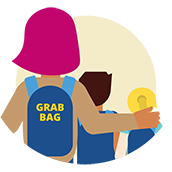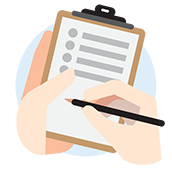Let's get readyMe takatū
Find ideas and resources for teaching students about preparedness.
On this page
Responding to scenarios
Using scenarios works well with older students. They are more able to separate fact from fiction and apply a fictitious scenario to action in real life. A range of scenarios are presented below.
How could you use these scenarios?
- Discuss each one in a group.
- Make a plan or flowchart for how you could help someone in your neighbourhood before or during an emergency.
- Mime or act them out in a group.
- Use them as topics for impromptu speeches.
- Write your own ‘What if?’ situations.
- Make a game such as Snakes and Ladders.
- Create digital comics or voicethread presentations.
- Use them as a way to creatively share a preparedness message with other students in the school.
- Present a scenario to the class and ask students what they would do. Use the material on QuakeStories as an exemplar. Students can write their own fictional account or accounts of their own emergencies that have happened to them.
These scenarios can be useful for short, teachable moments after a drill or practice. Discuss with students what they would do in some of these scenarios if they happened at lunchtime or during breaks. Create a Safety Action Plan with the class for your class’s needs.
-
What if:
- You are sitting at your desk at school when the room begins to shake. Windows smash and the computer screen crashes to the floor.
- You are playing outside when the ground starts to shake. Younger children around you start screaming.
- The school is closing early due to bad weather and a fast rising river close by. You know your parent or caregiver who usually picks you up is still at work.
- You are outside when the wind suddenly strengthens and objects begin to get blown about.
- You are in the classroom during bad weather. The wind is getting really strong and it shatters a window.
-
What if:
- Shaking has brought down the chimney in your house, creating a hole in the roof.
- The river beside your house has broken its banks in a storm and the water level is rising.
- You are listening to the radio when there is a Civil Defence siren alert noise followed by a special message. It's a tornado warning. The tornado is heading in your direction.
- Your family are all asleep in bed when a noise wakes you up. Furniture is falling over and pictures are falling off the walls.
- It has been raining heavily all night and all day. A flood warning has been issued for your area.
- Due to an earthquake, water pipes have burst in your house. Your parents are not at home and the lounge is starting to flood.
- It is evening and it is dark outside. The power goes off. You have no lights, phone or internet.
- The bank at the back of your house is slipping down towards a bedroom where your little brother is sleeping.
-
What if:
- While walking to school one morning, the ground begins to shake.
- After a major storm, you notice a broken power line across the footpath.
- A tsunami warning has been given. You have been advised by radio to evacuate the area. Your parents are not at home.
- You are walking home from school after some very heavy rain. A very deep puddle of water blocks your way.
- You meet a friend after school in the park. You notice the sky getting dark and see bolts of lightning. Heavy rain begins to fall. Loud claps of thunder echo all around.
- You are at the supermarket when the ground begins to shake and items start falling from the shelves.
-
What if:
- While holidaying at the beach you feel a strong earthquake. You notice the sea dropping back from the shore.
- To get from your camping spot to the beach, you have to cross a small river. After heavy rain, the river has risen.
- While on holiday, warnings are given over the radio that a nearby volcano is erupting.
- You are on holiday with your family on a boat. The weather turns nasty and you are now being washed towards the rocky shore.
- You are in a hotel when there is a low rumbling sound and the floor begins to shake.
Impacts and superheroes
Have a look at the seven impacts of emergency events by looking at the IMPACTS Team.
Assign one impact to individuals, pairs or small groups of students. Ask them to complete the following activities.
- Discuss, collect or design the objects you think you might need to prepare for your emergency. Design a container suitable for your items so that you can carry everything if you need to leave home.
- Ask for help from the school community to translate your ideas into a language other than English. Put this into the school newsletter or other regular communications.
- Make emergency plans for the ways you would prepare for an emergency. Think about what resources you would have, who you might be with and what you could do now to mitigate future impacts. Share your plans on a class blog or send an email home.
- Explore ways to help disabled people or older people prepare for or cope with the impact of an emergency event. How might the IMPACTS superheroes look after them?
- Explore ways to help pets or other animals to prepare for and cope with the impact of an emergency.
- Design a way to present the impacts to a younger class, your whānau or a community group. Create a prototype and get feedback on it from other class members. Make necessary adjustments and deliver/present it to your audience.
School emergency response procedures and plans
In groups, review the school’s emergency evacuation plans and emergency response procedures. If the school has various plans, give different plans to each group. Discuss the plans within each group to ensure that everyone knows what to do in the event of an emergency.
Divide the groups in half — each group teaches another group what to do. Keep swapping groups until everyone has been through all the emergency response procedures. If the school has only one or two plans, go through these as a class.
Are these school procedures and plans effective and clear for everyone?
- What other plans might we need?
- Can we communicate the information more clearly or in a different way?
- How do we make students and families aware of these plans and procedures?
- How often do we practise these plans? Is it often enough or too often?
- How can we improve the effectiveness of our plans?
Brainstorm a list of ways to improve the school plans and procedures. Ideas might include the following.
- Sharing information with classes or families or at assembly.
- Drafting other emergency plans to present to the principal or Board of Trustees.
- Writing emergency preparedness messages for the school newsletter.
- Making a timetable or checklist for the school to help check that drills have been completed.
- Including images/photographs with written plans and procedures to visually communicate key messages.
- Creating a school emergency procedure video like the Air New Zealand safety videos.
Emergency planning at government, community and family levels
Ask students what actions can be taken to prepare for emergency impacts. Create a chart or poster with information about actions at the three levels.
- At a government level
- Investigate the role and activities of the National Emergency Management Agency and the Natural Hazards Commission Toka Tū Ake. Include what might happen if we didn’t have these organisations. Compare with other countries.
- Investigate other ways government helps ensure we are ready for emergencies.
- At a community level
- Investigate the role of emergency services and disaster relief agencies like Red Cross.
- At a whānau level
- Investigate ways groups and individuals can be proactive in their preparation.
- Visit What’s The Plan Stan?
Suggestions for discussion and debate.
- Should kids need to be prepared for an emergency?
- Why do we need to prepare at all? This is never going to happen!
- Can kids help in times of an emergency event?
Home learning
Students can create a home emergency plan with their families. Students could share their plans of how to deal with all seven impacts with the class.
Students can visit Natural Hazards Commission Toka Tū Ake and list the ways they can quake safe their home. They can talk with their whānau about what action they have taken so far, and what further action they can take. The PDF Easy Ways To Quake Safe Your Home provides more information.

Visit the Natural Hazards Commission Toka Tū Ake website for more information on making your home safer.

Find resources from Natural Hazards Commission Toka Tū Ake that will help you better prepare for natural disasters and recover afterwards. Resources include Easy Ways to Quake Safe Your Home and a kids activity book.
Lesson ideas for years 4–8
What's the Plan, Stan? has suggestions for teaching and learning programmes for students in years 4–8. It focuses on emergency events and the impacts they could have on your community.




